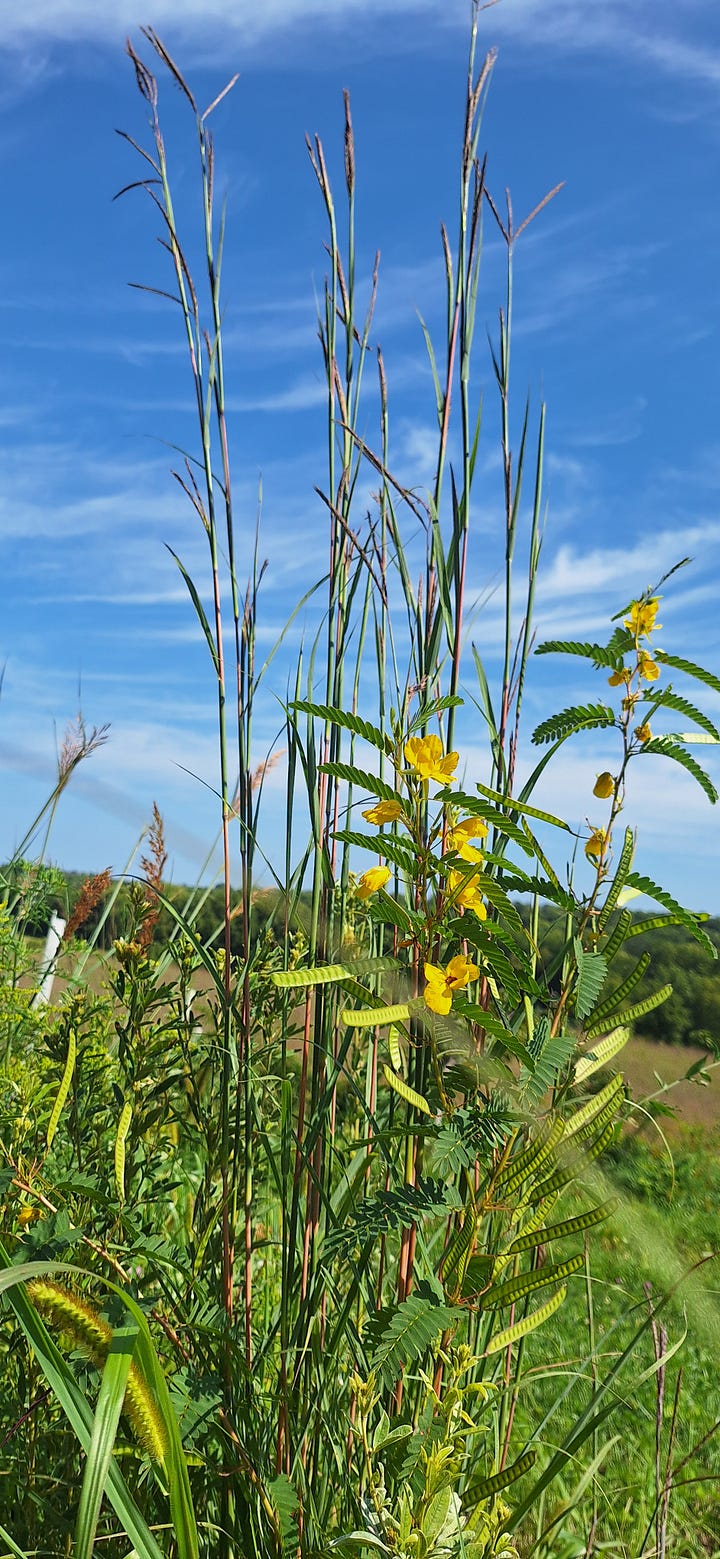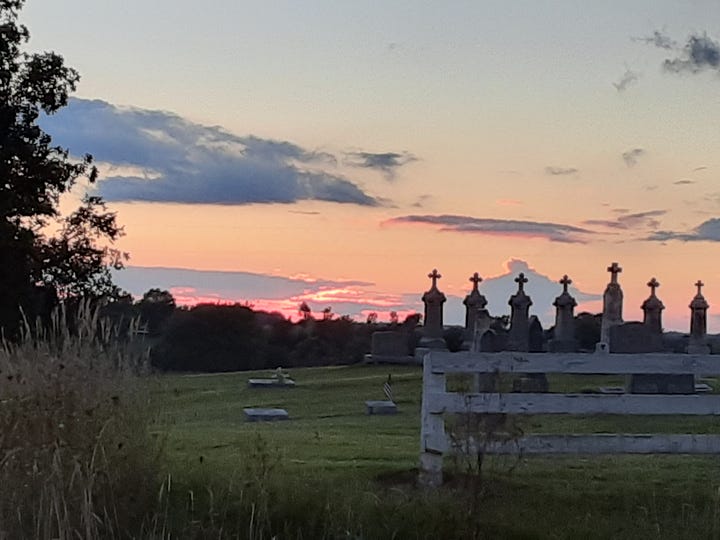
It’s been a pleasantly cool August, though a heat wave is headed our way. I’m required to add that if I want to sound Iowan. Besides, it’s true.
The warm season grasses are slowing down while the cool season ones in the prairie continue to stretch beyond reach. The pear trees are loaded with fruit. Chestnut burrs are expanding. And election season has begun.
I never saw it coming, but suddenly I’m neck deep as the “campaign coordinator” for Phil Wiese, a guy I didn’t even know existed until three weeks ago. He showed up in my local paper with a profile that told me this time, finally, we might send our current trainwreck of a state representative home to his sad little scrapping business in the backend of Cedar County.
It wasn’t because Phil was right on all the things I care about. He didn’t even say. What convinced me was first that he was a 6th generation farmer and volunteer firefighter from the other (more conservative) side of the district and second, he wanted to bring dignity and respect back to Des Moines.
Did you get that? A politician talking about bringing respect back to the halls where our laws are made!
Never in my lifetime would I have thought that was a radical act. Now it is. When our current state representative gives the double middle finger at the podium in the capitol rotunda or calls anyone who disagrees with him a “radical socialist” and still gets elected six times in a row, he has moved the needle. It’s hard to believe anyone could bring it back to where it was for more than 200 years – to the kind of passionate but respectful debate upon which our democracy was founded.
It’s hard to believe because nowadays it’s all about who can grab more crumbs faster. If I’ve got less, it’s my neighbor’s fault. If he’s got more, it’s at my expense. Doubly so if he’s gay or Black or Brown or speaks with foreign accent. So much worse if it’s some uppity woman who clearly didn’t get the memo that God created her to breed. Get over it already.
Our so-called leaders fan the flames of this magical shell game of hate, fear and scarcity. While we’re distracted by finding new ways to hate on each other, they’re paying off their corporate friends by eliminating federal rule-making, sending public money to private (for profit) schools and appointing activist judges. The result is that even the good-hearted Americans who truly believe in democracy are so disillusioned they don’t vote. Chalk another one up for the oligarchy. (For those of you who graduated from an underfunded public school, that’s rule by a few.)
The prairie has taught me an undeniable truth – that many different beings can live in the same place and still thrive. Big and little bluestem, showy partridge pea, wild bergamot, pale purple coneflower, Indiangrass, prairie dropseed, gray-headed coneflower, common goldenrod, stiff goldenrod, Virginia mountain mint…the list goes on. Each comes up in its season and then fades away making room for another. Their roots all share the same soil, making way for one another, biding their time for their turn to push their greenery up and into the bright, hot day. They all sleep in the same place through winter.
The prairie doesn’t fear scarcity. It assumes abundance – that there will always be sun, air and soil. In doing so, it creates abundance for microbes, insects, birds and mammals. I see bluebirds and red-winged blackbirds, dragonflies, quail and pheasant, deer, groundhogs and rabbits, turkeys and sometimes a bobcat. They all thrive off of an ecosystem of every different kind of flower and grass.
Of course, the prairie’s assumption is wrong. There isn’t always abundance.
Iowa has successfully wiped out more than 90 percent of its prairie in favor of corn and soybeans. Whatever seed bank once existed in the soil has been torn up or compacted far below the surface. We spray and till and spray again to keep the survivors from emerging and competing with our comparatively wimpy corn and beans. (My friend
from Full Time Farmer marvels at corn’s deep root system. I invite him to take a look at the 17-foot-long big blue stem root system some day!)Almost every tallgrass prairie plant is listed on the Round Up label. They are weeds. They compete. Kill them.
So like us, the prairie sometimes has a bad day, or in prairie terms, a bad couple hundred years. It suffers setbacks. But also like us, it’s resilient. It will break through the weakest places in gravel, blacktop and concrete. If left alone long enough, a cornfield will revert to prairie before succession sends trees marching into it.
My neighbor was one of the first in recent times to collect prairie seed from roadsides and ditches more than 40 years ago. One seed at a time, carefully placed in separate paper sacks, kept cold over winter and then delicately planted by hand just so. Some prairie seeds are so tiny it takes 1.5 million of them to make a single ounce. This is love. This is vision. This is care. And her prairie is a thing of beauty.
Now, there are scores of successful companies that breed and sell prairie seed of all kinds. There are even multiple federal programs that will help pay to plant it on farmland. Prairie’s seeing a comeback.
I believe respect in politics is also seeing a comeback. The times they are a’changing, as they say.
It’s time to put the scarcity and fear to bed and get on with the business of surviving and thriving with each other. This isn’t kumbaya. It’s hard work. It’s scary at times. I don’t always know if the Black man walking toward me will assume I’m racist just because I’m White. I don’t always understand what the Southeast Asian guy selling me groceries is saying. I get tired of calling Mumbai when I need help for anything technical. (I have learned that a friendly smile goes a long way in most cases, and yeah, they can even hear it over the phone.)
And I wonder if our world so full of war and climate refugees will allow a future where two people have the luxury of owning 75 acres or one family of owning 5,000 or more. It’s likely to get crowded around here. We can decide how we’ll respond.
Humans evolved by cooperating with one another. It’s time we remember how to do that if we’re to survive the challenges we face as a species.
It also wouldn’t hurt to learn better how to identify our predators, because they’re out there and they want us gone.
More photos from in and around Draco Hill Nature Farm, home of Postcards from the Heartland









